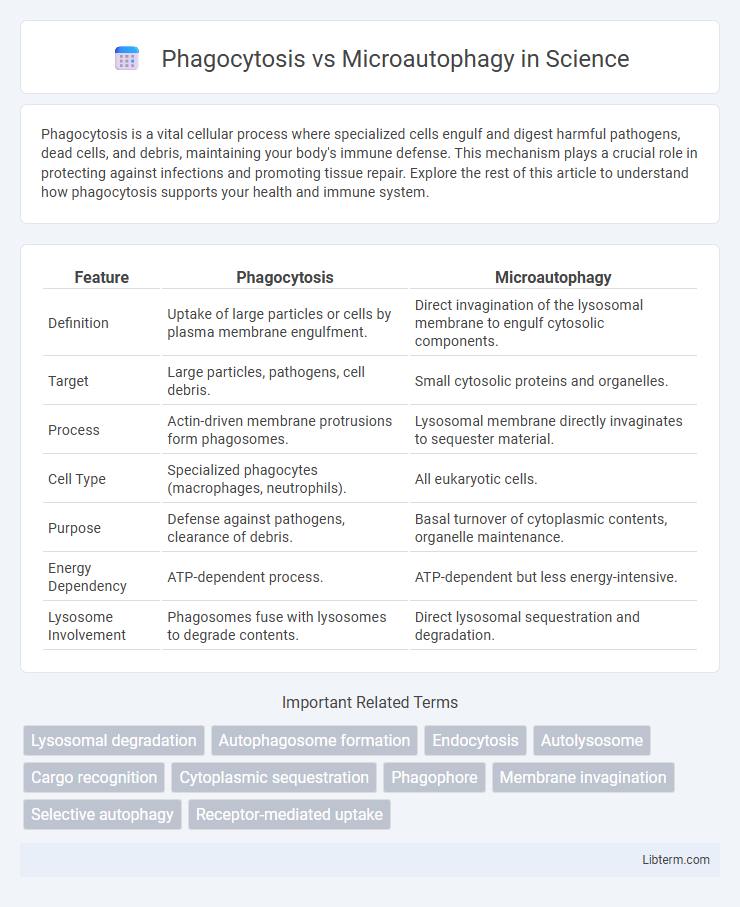Phagocytosis is a vital cellular process where specialized cells engulf and digest harmful pathogens, dead cells, and debris, maintaining your body's immune defense. This mechanism plays a crucial role in protecting against infections and promoting tissue repair. Explore the rest of this article to understand how phagocytosis supports your health and immune system.
Table of Comparison
| Feature | Phagocytosis | Microautophagy |
|---|---|---|
| Definition | Uptake of large particles or cells by plasma membrane engulfment. | Direct invagination of the lysosomal membrane to engulf cytosolic components. |
| Target | Large particles, pathogens, cell debris. | Small cytosolic proteins and organelles. |
| Process | Actin-driven membrane protrusions form phagosomes. | Lysosomal membrane directly invaginates to sequester material. |
| Cell Type | Specialized phagocytes (macrophages, neutrophils). | All eukaryotic cells. |
| Purpose | Defense against pathogens, clearance of debris. | Basal turnover of cytoplasmic contents, organelle maintenance. |
| Energy Dependency | ATP-dependent process. | ATP-dependent but less energy-intensive. |
| Lysosome Involvement | Phagosomes fuse with lysosomes to degrade contents. | Direct lysosomal sequestration and degradation. |
Introduction to Cellular Degradation Pathways
Phagocytosis and microautophagy are essential cellular degradation pathways that maintain homeostasis by eliminating unwanted materials. Phagocytosis involves the engulfment of large particles or pathogens by the plasma membrane, forming phagosomes that fuse with lysosomes for degradation. In contrast, microautophagy directly engulfs cytosolic components into lysosomes through membrane invagination, enabling selective breakdown of intracellular constituents.
Defining Phagocytosis
Phagocytosis is a cellular process where specialized cells, such as macrophages, engulf large particles, including pathogens or cellular debris, by extending their plasma membrane to form a phagosome. This vesicle then fuses with lysosomes to degrade the engulfed material, playing a critical role in immune defense and tissue homeostasis. In contrast, microautophagy involves direct lysosomal membrane invagination to sequester and degrade small cytosolic components, highlighting a distinction in substrate size and mechanism.
Defining Microautophagy
Microautophagy is a lysosomal degradation process where the lysosome directly engulfs cytoplasmic components through membrane invagination, distinguishing it from phagocytosis, which involves the engulfment of large extracellular particles by specialized cells. This autophagic pathway maintains cellular homeostasis by recycling smaller portions of cytoplasm and damaged organelles in a continuous and non-selective manner. Key molecular players in microautophagy include the lysosomal membrane proteins that facilitate membrane curvature and invagination essential for cargo sequestration.
Key Molecular Mechanisms Involved
Phagocytosis involves the recognition and engulfment of large particles via receptor-mediated signaling pathways, primarily regulated by actin cytoskeleton remodeling through proteins like Rac and Cdc42, and the formation of phagosomes. Microautophagy directly captures cytoplasmic components by invagination of the lysosomal membrane, relying on membrane bending proteins such as ESCRT complexes and specific lipid-modifying enzymes. Both processes require coordinated activity of Rab GTPases for vesicle trafficking and lysosomal fusion, but differ in membrane dynamics and cargo selectivity mechanisms.
Types of Substrates Targeted
Phagocytosis primarily targets large extracellular particles such as bacteria, cell debris, and apoptotic cells for engulfment and degradation, playing a crucial role in immune defense and tissue homeostasis. Microautophagy involves the direct engulfment of small cytoplasmic components, including soluble proteins, damaged organelles, and lipid droplets, through lysosomal membrane invagination. The specificity of substrate selection varies significantly, with phagocytosis handling bulkier extracellular materials and microautophagy focusing on intracellular quality control.
Cellular Locations of Activity
Phagocytosis occurs primarily at the plasma membrane where cells engulf large particles or pathogens into phagosomes for degradation. Microautophagy takes place directly at the lysosomal membrane, involving the invagination of the lysosomal membrane to sequester cytosolic components. The distinct cellular locations underline their roles in targeted degradation, with phagocytosis acting extracellularly and microautophagy functioning intracellularly within lysosomes.
Regulatory Processes and Signaling
Phagocytosis is regulated primarily by receptors like Fc receptors and complement receptors that activate signaling pathways involving PI3K, Rac, and actin polymerization to facilitate engulfment of large particles or pathogens. Microautophagy is controlled by nutrient-sensing pathways such as mTOR and AMPK, which modulate lysosomal membrane invagination and autophagosome formation through signaling molecules like Atg proteins. Both processes rely on intricate regulatory networks to maintain cellular homeostasis by dynamically responding to environmental cues and intracellular stress signals.
Biological Roles and Importance
Phagocytosis is a cellular process that engulfs large particles, such as pathogens and debris, playing a crucial role in immune defense and tissue homeostasis. Microautophagy involves the direct engulfment of cytoplasmic components by lysosomes, contributing to nutrient recycling and cellular quality control. Both mechanisms maintain cellular health by removing harmful materials, but phagocytosis primarily targets extracellular threats while microautophagy manages intracellular components.
Similarities and Differences
Phagocytosis and microautophagy are cellular processes involved in the degradation and recycling of cellular components, where phagocytosis engulfs large particles or microorganisms via membrane invagination, forming phagosomes, while microautophagy directly engulfs cytoplasmic material by lysosomal membrane invagination. Both processes facilitate intracellular digestion and maintain cellular homeostasis through lysosomal degradation, but phagocytosis is primarily an immune response to external particles, whereas microautophagy targets endogenous cytosolic components for turnover. Key differences include the scale of material engulfed and the involvement of distinct membrane dynamics, with phagocytosis relying on extensive membrane remodeling and microautophagy using lysosomal membrane invagination for direct uptake.
Clinical Implications and Future Perspectives
Phagocytosis primarily targets extracellular pathogens and cellular debris, playing a crucial role in immune defense and inflammation regulation, which has direct implications for treating infections and autoimmune diseases. Microautophagy facilitates the selective degradation of cytosolic components, influencing cellular homeostasis and stress responses, making it a potential therapeutic target for neurodegenerative disorders and cancer. Advances in understanding the molecular mechanisms of both processes could lead to precision therapies that modulate autophagic pathways for improved clinical outcomes.
Phagocytosis Infographic

 libterm.com
libterm.com